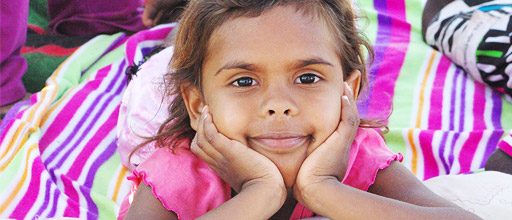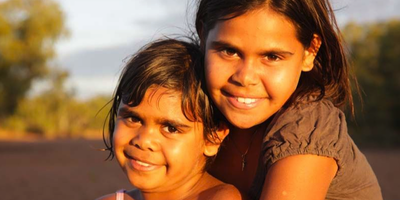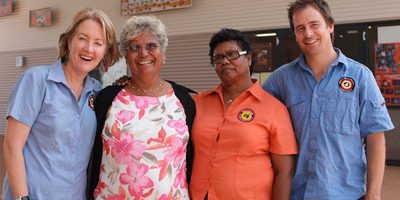
Fetal alcohol syndrome findings to protect future generations
One in eight children born in 2002 or 2003 and living in remote Fitzroy Valley communities in Western Australia have Fetal Alcohol Syndrome, a landmark study has found.
The Lililwan* study, published today in the Journal of Paediatrics and Child Health, was initiated by Aboriginal community leaders who, in 2009, invited researchers and clinicians to partner with them to provide data they could use to advocate for people living with Fetal Alcohol Syndrome.
Fetal Alcohol Syndrome is one of a group of preventable, lifelong conditions (the Fetal Alcohol Spectrum Disorders) that may result from alcohol use in pregnancy, and can cause low IQ, delays in development, and problems with learning, academic achievement, behaviour, motor function, speech and language and memory. It is also characterised by abnormal facial features and poor growth, before or after birth.
The Lililwan study, led by Aboriginal leaders from the Fitzroy Valley communities, The George Institute for Global Health and The University of Sydney, provides Australia’s first comprehensive data on the prevalence of Fetal Alcohol Syndrome in remote communities. This ‘research in action’ project included diagnosis and development of individualised management plans to address the health issues of each child.
Ms June Oscar, a study Chief Investigator and CEO of Marninwarntikura Women’s Resource Centre in Fitzroy Crossing said “This information is very important because we can use it to lobby for changes across Australia. This work helps us understand, for the first time, the scale of the problem of Fetal Alcohol Syndrome.”
“Already big changes have been made in our community, including restricting access to alcohol and implementing health promotion strategies, diagnostic clinics and therapy and support for children and families. We know that there are many other communities across Australia worried about the damage that alcohol is causing to their children. The problems we face are not unique to the Fitzroy Valley.”
Chief investigator Professor Jane Latimer, of The George Institute for Global Health and The University of Sydney, said “The Fitzroy Valley communities are courageous and brave – they are taking responsibility for the past and working towards a better future.”
“These women did not know they were harming their babies by drinking when they were pregnant. They live in very remote, disadvantaged communities and 10 years ago, when their children were born, they had no information about the dangers of alcohol.”
“We must commend, rather than punish, this community for leading the way and shining a spotlight on a problem that exists across all Australia.”
Chief investigator and senior author Professor Elizabeth Elliott of The University of Sydney, and an internationally-recognised expert in Fetal Alcohol Syndrome, said “These tragic results confirm the urgent need for effective, national programs to prevent alcohol use in pregnancy, raise community awareness, and provide treatment and support for children and families living with Fetal Alcohol Syndrome in Australia.”
Professor Elliott, who is Chair of the Commonwealth Government’s recently formed National FASD Technical Network, said: “The prevalence rate we report for Fetal Alcohol Syndrome, at 120 per 1,000 children aged seven to nine years, is the highest documented in Australia.
“These are the first reliable figures we have from a remote Australian community in which high-risk alcohol use is common, but they are consistent with figures detected in high-risk drinking communities internationally. They will assist us in advocating for services and prevention programs.”
“In light of these results, I am pleased that the government has recently committed over $9 million for the prevention and management of FASD in Australia, with an emphasis on Indigenous communities” said Professor Elliott.
Paediatrician Dr James Fitzpatrick, a study Chief Investigator from the University of Sydney and The George Institute, said the diagnosis of Fetal Alcohol Syndrome in the Fitzroy Valley study was made using internationally recognised criteria, following a rigorous process that included a detailed questionnaire about the pregnancy and early childhood and a comprehensive health and development assessment by a multi-disciplinary team of clinicians.’
Dr Fitzpatrick, the study’s first author, said: “We combined the best of community engagement and participation, with a scientifically rigorous approach that was practically useful to children, families and schools.
“Each child underwent three days of assessment, including by a paediatrician, psychologist, occupational therapist, physiotherapist, and speech and language pathologist. Aboriginal ‘community navigators’ were involved at every stage, ensuring that families were fully informed and understood the process.
“The study was challenging due to the very remote location of the 45 communities visited, limited accommodation, extreme climate and difficult roads.”
Dr Fitzpatrick, who is now based at the Telethon Kids Institute and continues to work in the Fitzroy Valley said: “Families are more aware of FASD now, and health and education services have come together to implement a sustained response.”
Ms Maureen Carter, a study Chief Investigator and CEO of Nindilingarri Cultural Health Services, was instrumental in initiating and overseeing this study. She said “The role of Aboriginal ‘community navigators’ was crucial in ensuring cultural safety and competence. They acted as interpreters of local languages and brokered all relationships between researchers, families and communities.”
“I have seen first hand the awful impact of Fetal Alcohol Syndrome in my community and am dedicated to preventing alcohol use in pregnancy and its consequences.”
The Lililwan study represents a successful collaboration between two Aboriginal organisations (Nindilingarri Cultural Health Services and Marninwarntikura Women’s Resource Centre), both in Fitzroy Crossing, and clinicians and researchers from The George Institute for Global Health and The University of Sydney Medical School’s Discipline of Paediatrics and Child Health.
“This study highlights the power of collaboration in research between Aboriginal and non-Aboriginal partners to address community priorities, and the importance of respecting local culture and knowledge” said Ms Carter.
It was supported by the Commonwealth Departments of Health and Ageing and Families, Housing Community Services and Indigenous Affairs; and the National Health and Medical Research Council of Australia.
Maya Kay,
Communications Manager Australia,
The George Institute for Global Health
Tel: +61 424 195 878




